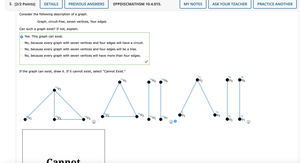- Information
- AI Chat
lesson 10.1 part 1
Discrete Mathematics (MATH 2310)
University of Arkansas at Little Rock
Preview text
Math 2310 Discrete Math Lecture 40 Graphs: Definitions and Basic Properties, Part 1 LearNiNg Objectives 1) To learn the concept of a graph. 2) To learn the basic terminology associated with graphs. 3) To learn the concept of a directed graph (also KNOWN as a digraph). 4) To coNsider some examples. Graphs A graph consists of vertices ( the plural of vertex) and line segments called edges. Below is a pictoral representation of a graph. 1 Math 2310 Discrete Math Lecture 40 Graphs: Definitions and Basic Properties, Part 1 LearNiNg Objectives 1) To learn the concept of a graph. 2) To learn the basic terminology associated with graphs. 3) To learn the concept of a directed graph (also KNOWN as a digraph). 4) To coNsider some examples. Graphs A graph consists of vertices ( the plural of vertex) and line segments called edges. Below is a pictoral representation of a graph. 1 V2 Isolated e A Vq vertex V1 e2 e3 C7 parallel V3 e4 V4 V7 edges V6 V8 C5 V5 eb Loop Vertices are labeled with and edges with AN edge that connects a vertex to itself is called a loop. If two edges connect the same vertices they are called parallel (e. e, and e2). Edges always begin and end at a vertex. Edges can cross ONe another. A vertex that is Not connected to any edge is said to be isolated (e. V7). Def: A graph G consists of two finite sets: a NONempty set VCG) of vertices and a set E(G) 2 V2 Isolated e A Vq vertex V1 e2 e3 C7 parallel V3 e4 V4 V7 edges V6 V8 C5 V5 eb Loop Vertices are labeled with and edges with AN edge that connects a vertex to itself is called a loop. If two edges connect the same vertices they are called parallel (e. e, and e2). Edges always begin and end at a vertex. Edges can cross ONe another. A vertex that is Not connected to any edge is said to be isolated (e. V7). Def: A graph G consists of two finite sets: a NONempty set VCG) of vertices and a set E(G) 2






